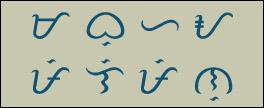Socio-Cultural: Pre-Colonial Era
According to the other viewpoint, the early Filipinos were not passive recipients of cultures but also
active transmitters and synthethizers of them. For example, comparative studies of Pacific cultures show that some of the inhabitants of
Moreover, by the time the Spaniards came to the
Early Filipinos used small arquebuses, or portable cannons made up of bronze. Larger cannons, on the other hand, were made of iron and resembling culverins provided heavier firepower. The iron cannon at Rajah Sulayman's house was about 17 feet long and was made from clay and wax moulds.
Guns were also locally manufactured and used by the natives. The most fearsome among these native guns was the lantaka, or swivel gun, which allowed the gunner to quickly track a moving target. Some of the weaponry used by the natives was quite unusual. For instance, one weapon was the prototype of the modern-day yoyo, and it returned to is owner after being flung at an opponent.
Swords were also part of the native weaponry. Making of swords involved elaborate rituals that were based mainly on the auspicious conjunctions of planets. The passage of the sword from the maker entailed a mystical ceremony that was coupled with superstitious beliefs. The lowlanders of Luzon no longer use of the bararao, while the Moros and animists of the South still continue the tradition of making kampilan and kris.

Kampilan

Kris
In addition to weaponry, the early Filipinos made good armor for use in the battlefield and built strong fortress called
System of Writing
Early Filipinos devised and used their own system of writings from 300 BC, which derived from the Brahmic family of scripts of Ancient India. Baybayin or Alibata became the most widespread of these derived scripts by the 11th century AD.

Example of an Alibata
One example of pre-Spanish Philippine script on a burial jar, derived from Brahmi survives, as most of the writing was done on perishable bamboo or leaves; an earthenware burial jar dated 1200s or 1300s with script was found in Batangas. This script is called in Baybayin or Alibata.
Religion
As expressed in their native literature, Filipino culture at the time of discovery was high. Native literature started as a manifestation of the people's love to their deities, anitos, spirits, gods and goddesses. It consisted of songs (awits or dalits), maxims or sabi, riddles or bugtong, prayers, proverbs or sawikain, and of "a kind of face representing and criticizing local customs (examples are duplo and karagatan in which riddles or bugtong play a considerable role)." According to early historians, there were no less than twenty kinds of songs. In prose, they had fables and drolls. The native plays were invariably associated with music. The players danced and sang to the accompaniment of the string instruments called codyapi, bangsi and colelong. The music and the dance were executed not only as a form of amusement but as a serious occupation.
Superstition
Before the arrival of the Spaniards, and the introduction of Roman Catholicism and Western Culture in the 1500s, the indigenous Malayo-Polynesian tribes of the Philippines were adherents of a mixture of Animism, Islam, Hinduism and Buddhism. Primitive gods and goddesses include "Araw" (Sun) and "Buwan" (moon), who are people who appear to remove tumors and diseased tissue by sticking their hands into a patient's body and extracting human flesh and blood, but leaving the patient scar free. Some see this performance as a sleigth of hand false interpretation. Believers accept it as true, and accept it as an alternative healing method, and a way to take advantage of the placebo effect.
Visual arts
Itneg and Mindanao Tribal art
The Itneg tribes are known for their intricate weaving production. The binakol is a blanket which features optical illusion designs. Weavings of the Ga'dang tribe usually have bright red tones. Their weaving can also be identified by beaded ornamentation. Other tribes such as the Ilongot make jewelry from pearl, red hornbill beak, plants and metals.

Itneg weaved cloth
The tribes of Mindanao such as the B'laan, Mandaya, Mansaka and T'boli became skilled in art of dyeing abaca fibre. Abaca is a plant, and its leaves are used to make fibre known as Manila hemp. The fibre is dyed by a method called ikat. Ikat textiles are woven into geometric patterns with human, animal and plant pictorial themes.

Dyed and designed manila hemp is called an "Ikat" textile
Islamic art
Islamic art in the Philippines
Architecture
The Nipa Hut(Bahay Kubo) is the mainstream form of housing. It is characterized by use of simple materials such as bamboo and coconut as the main sources of wood. Cogon grass, Nipa palm leaves and coconut fronds are used as roof thatching. Most primitive homes are built on stilts due to frequent flooding during the rainy season. Regional variations include the use of thicker, and denser roof thatching in mountain areas, or longer stilts on coastal areas particularly if the structure is built over water. The architecture of other indigenous tribes may be characterized by an angular wooden roofs, bamboo in place of leafy thatching and ornate wooden carvings.

Authentic Nipa hut
Traditional Filipino Games
Traditional Filipino games include yo-yo, piko, patintero, bahay kubo, and sungka .Sungka is played on a board game using small sea shells in which players try to take all shells. The winner is determined by who has the most shells at the point when all small pits become empty. Filipinos have created toys using insects such as tying a beetle to string, and sweeping it circular rotation to make an interesting sound.

Sungka



